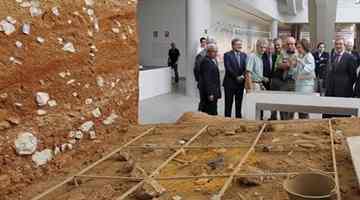Queen Sofia yesterday opened a €70 million Museum of Human Evolution in Burgos, near the archaeological site of Atapuerca in Spain.
 The largest museum of its kind in the world, it houses reconstructions of important sites and is the main centre for museum conservation of all the originals unearthed.
The largest museum of its kind in the world, it houses reconstructions of important sites and is the main centre for museum conservation of all the originals unearthed.
Covering a total area of 15,000 square metres, where the permanent exhibition will share space with temporary displays, the museum is expected to attract 300,000 visitors every year.
The permanent exhibits and functions of the Museum of Human Evolution are complemented by the National Research Centre of Human Evolution (CENIEH) and an auditorium, which will complete the cultural and educational attractions of this relevant centre in the international arena.
The architectural ensemble has been designed by the architect Juan Navarro Baldeweg.
The museum features the history and presentation of the site and of the role of homo heidelbergensis in the human evolution tree. It includes a description of the complicated access and location of the site within the system of cavities of the Cueva Mayor, the use of the cave by humans and an infographics production of "Skull 5", showing both the external surface and the interior of the skull.
There is the biface called "Excalibur", presented as, possibly, the first known funeral offering in the history of mankind (illustrated by means of an audiovisual presentation).
Also on display is the famous pelvis known as "Elvis" – the most complete hip which is about 400,000 years old. It is compared to a modern pelvis and serves as an introduction to an installation that explains how the proportions of the human extremities have changed throughout the evolution process.
Atapuerca fact sheet
- The Atapuerca mountains are located within the towns of Atapuerca and Ibeas de Juarros, in Castile and León, some 15 kilometres from the city of Burgos.
- Unesco added the pleistocene sites of the Atapuerca mountains to its list of World Heritage Sites in December 2000.
- The human fossils recovered from Atapuerca so far constitute 85 per cent of all the world’s fossils from the period known as the Middle Pleistocene. Each new excavation confirms the status of this set of sites as one of the most significant settlements of the first Europeans.
- At the Atapuerca archaeological and palaeontological site three periods are represented, from which ancient human remains and cultural materials of great antiquity have been recovered.
- So far, 40 caves have been found in the karst site of the Atapuerca mountains and many of them have great archaeological or palaeontological potential. Intensive research work on the caves continues.
Source: Times of Malta [July 14, 2010]